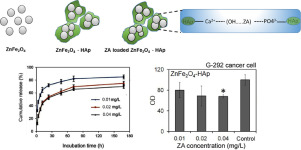Journal of the Taiwan Institute of Chemical Engineers ( IF 5.7 ) Pub Date : 2018-11-07 , DOI: 10.1016/j.jtice.2018.10.018 Amir Seyfoori , S.A. Seyyed Ebrahimi , Sajjad Omidian , Seyed Morteza Naghib

|
In this study, a co-precipitation method was applied to synthesize the ZnFe2O4 and ZnFe2O4Hydrxoapatite (HAp) nanostructures. The microstructure and morphological characteristics of the nanoparticles were studied and well discussed. A dose-dependent biological evaluation comprising of their minimum inhibitory concentration (MIC) antibacterial features as well as their magnetic characteristics were analyzed. The results of vibrating-sample magnetometer (VSM) showed nanoscaled ZnFe2O4
HAp had lower saturation magnetization as well as higher coercive field than ZnFe2O4, which enables the ZnFe2O4
HAp nanoparticles to stimulate cell proliferation, differentiation and adhesion. A remarkable inhibitory effect of the nanoscaled ZnFe2O4
HAp was recognized on bacterial proliferation and growth in the optimal dose, 0.078 mg/L. Besides, a dose-dependent cytocompatibility tests of the nanoparticles on the HEK normal cell and G292 cancer cell was assessed by 3-(4,5-Dimethylthiazol-2-Yl)-2,5-Diphenyltetrazolium Bromide assay (MTT). All nanoparticles were cytocompatible and no cytotoxicity effect on normal and cancer cells was observed in the dose-dependent test. In addition, an in vitro test of the drug release from drug-loaded ZnFe2O4-HAp nanocarrier were investigated and well described. The Inhibitory effect of the drug-loaded ZnFe2O4-HAp nanoparticles was investigated in-vitro so that the nanoparticle possessed the ability for inhibiting cancer cell proliferation and growth. By the increment of the nanoparticles concentrations, G292 cancer cell proliferation was inhibited, while, HEK normal cell proliferation was stimulated. Conclusively for the first time, a robust composite based nanostructure as a promising material was developed for multiple applications of bone filler, drug delivery and cancer treatment.
中文翻译:

多功能磁性ZnFe 2 O 4-羟基磷灰石纳米复合颗粒用于局部抗癌药物传递和抑制细菌感染的体外研究
在这项研究中,采用共沉淀法合成ZnFe 2 O 4和ZnFe 2 O 4羟基磷灰石(HAp)纳米结构。研究并充分讨论了纳米颗粒的微观结构和形态特征。分析了剂量依赖性生物学评估,包括其最小抑菌浓度(MIC)抗菌特性及其磁特性。振动样品磁强计(VSM)结果表明纳米级的ZnFe 2 ö 4
的HAp具有较低饱和磁化强度以及更高的矫顽场比的ZnFe 2 ö 4,这使的ZnFe 2 Ò 4
HAp纳米颗粒可刺激细胞增殖,分化和粘附。在最佳剂量0.078 mg / L时,纳米级ZnFe 2 O 4
HAp对细菌的增殖和生长具有显着的抑制作用。此外,通过3-(4,5-二甲基噻唑-2-Yl)-2,5-二苯基四唑溴化物(MTT)评估了纳米颗粒在HEK正常细胞和G292癌细胞上的剂量依赖性细胞相容性测试。所有纳米颗粒均具有细胞相容性,在剂量依赖性试验中未观察到对正常细胞和癌细胞有细胞毒性作用。另外,从载药的ZnFe 2 O 4中释放药物的体外测试-HAp纳米载体进行了研究并得到了很好的描述。体外研究了载药的ZnFe 2 O 4 -HAp纳米颗粒的抑制作用,从而使该纳米颗粒具有抑制癌细胞增殖和生长的能力。通过增加纳米颗粒的浓度,抑制了G292癌细胞的增殖,而刺激了HEK正常细胞的增殖。最终,这是首次将坚固的基于复合材料的纳米结构作为一种有前途的材料开发出来,可用于骨填充剂,药物输送和癌症治疗的多种应用。



























 京公网安备 11010802027423号
京公网安备 11010802027423号